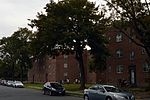Connecticut State University System
The Connecticut State Universities (CSU) are part of the Connecticut State Colleges & Universities, the largest public higher education system in Connecticut, and the second largest in New England. The four comprehensive state universities enroll almost 35,000 students and 180,000 alumni. The first of the universities to be founded was Central Connecticut State University, established in 1849 as a normal school for teacher education. Over time the other three institutions were founded as normal schools and in 1959 they were converted into state colleges to reflect their expanded mission. From their founding until 1965, they were overseen by the Connecticut State Department of Education. In 1965 the General Assembly transferred control of the then-colleges to an independent Board of Trustees. In 1983, the four institutions were converted into universities, together constituting the Connecticut State University System. The universities are governed by the Connecticut Board of Regents for Higher Education, established in 2011 to license and accredit the institutions and their programs, approve budgets, support planning, and coordinate technology operations. The president of the Board is Mark E. Ojakian. The Connecticut State University System Foundation, provides financial support from private donations to assist the missions of the universities.The system publishes a regular magazine, Universe, highlighting the academic and civic initiatives of the universities, and a semi-annual journal of contemporary literature and essays known as the Connecticut Review that was founded in 1967 by the Board of Trustees.The four universities – Central, Eastern, Southern and Western – offer graduate and undergraduate programs in more than 160 subject areas. Ninety-three percent of students are in-state residents and 86% of system graduates reside in Connecticut after graduation. The universities have experienced steady growth in recent years, as full-time enrollment is currently at an all-time high, and overall enrollment is at the highest level in the past two decades.
Excerpt from the Wikipedia article Connecticut State University System (License: CC BY-SA 3.0, Authors).Connecticut State University System
Woodland Street, Hartford
Geographical coordinates (GPS) Address Nearby Places Show on map
Geographical coordinates (GPS)
| Latitude | Longitude |
|---|---|
| N 41.77007 ° | E -72.70088 ° |
Address
Woodland Street 42
06105 Hartford
Connecticut, United States
Open on Google Maps








